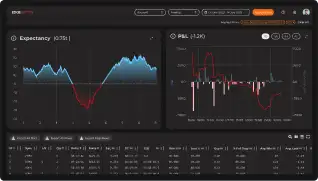
July 15,2025 @06:00 AM
At EdgeClear, our exclusive focus on futures and options on futures reflects our belief in their unmatched utility for active traders. This article explores these instruments in depth—examining what they are, how they differ, and why traders might choose one over the other.
What Is a Futures Contract?
A futures contract is a standardized agreement to buy or sell a specific asset at a predetermined price on a future date. These contracts are traded on regulated exchanges such as CME Group and are centrally cleared, reducing counterparty risk by ensuring that every trade is matched through a clearinghouse. However, this mechanism does not fully eliminate credit risk. Traders remain indirectly exposed to the financial stability of the firms responsible for holding and managing customer funds. A prime example is the E-mini S&P 500 futures (ticker ES), a cash-settled instrument valued at $50 × the S&P 500 index. It offers broad exposure to U.S. equities with capital efficiency—requiring only about 10% initial margin, equating to approximately 10 × notional leverage. Its deep liquidity and nearly 24-hour trading make it ideal for macro speculation, short term trading, or longer term positioning.
What Are Options on Futures?
An option on a futures contract provides the right—but not the obligation—to buy (call) or sell (put) a futures contract at a specific strike price before expiration. Unlike futures, options are asymmetric: the maximum loss for a buyer is the premium paid, while a seller (writer) may face unlimited risk. Check out the CME Group’s overview on options for a full breakdown of features.
Options are widely used on major CME futures such as commodities, currencies, and indexes. They support complex strategies like protective puts, spreads, straddles, and volatility trades.
Key Differences: Risk, Leverage, and Strategy
Risk Profile
Futures carry symmetric risk, meaning gains and losses are unlimited in either direction. For instance, a short ES futures position faces unlimited loss if the index rallies. In contrast, options, (except for uncovered selling of options), allows for defined risk—a call buyer’s worst-case scenario is the loss of their premium. Traders utilizing spreads, depending on the type, may only have the risk of the difference between the entry prices as their risk. Options also introduce time decay (theta risk), which futures do not.
Leverage and Capital Efficiency
As CME notes, one E-mini ES contract offers about 60x the buying power of an equivalent stock basket. See CME’s leverage explanation.
Options offer a different form of leverage. For instance, controlling $225,000 in S&P notional value might require $11,300 via ES margin, but only ~$9,800 through an at-the-money 3-month call. Both provide high leverage, but options can offer lower capital outlay and defined risk.
Strategy
Futures are direct and efficient: go long for bullish, short for bearish. They suit high-frequency and algo trading since there are no uptick rules or borrow constraints. Read the CME Group’s Benefits of Day Trading Futures for a deeper dive into the pros of futures.
Options, on the other hand, enable nuanced strategies. Traders can use spreads for range-bound markets, straddles to approach volatility, or protective puts for insurance. Traders may favor options when seeking risk-defined structures, while futures offer pure directional leverage. If you look at futures akin to the “Chess” of the financial markets, then options on futures are like playing 3D Chess.
Futures vs. Options: When a Trader Might Utilize Each
A trader may focus on outright futures for:
- Simple, linear market exposure
- Low execution cost and tight spreads
- No time decay
A trader may utilize options on futures for:
- Defined-risk positions
- Volatility trading
- Hedging an existing position (protective put or call)
Liquidity Comparison
Liquidity is vital for active traders. The E-mini S&P 500 futures average 1.8 million contracts daily, with deep open interest and razor-thin bid/ask spreads. To compare, S&P 500 index options (like SPX) trade about 3 million contracts per day in aggregate.
Futures markets also offer extended trading hours (Sunday night–Friday), which improves execution flexibility and price discovery.
However, it is important to note that liquidity for options on futures can vary significantly across products. While some contracts—like options on equity indexes or crude oil—may trade with ample volume and tight spreads, others may be less actively traded. This can lead to wider bid/ask spreads and greater slippage, especially for more complex or longer-dated option structures. In contrast, the underlying futures contracts for those same products may offer much more liquidity, making them preferable for traders prioritizing execution efficiency.
From Options to Futures: My Journey as a Trader

When I first started trading, I jumped into options contracts. At the time, I didn’t fully realize how complex they could be — with so many moving parts like implied volatility, time decay, and the other infamous Greeks, it was a steep learning curve.
One of the biggest challenges I faced early on was being right about the market direction but still losing on the trade. I remember one instance where I bought a call on SPY right before a modest rally. I was spot-on with my directional call, but theta decay and a drop in implied volatility worked against me. By the time the contract expired, I was staring at a loss despite being “right.” That was frustrating, and more importantly, eye-opening.
Eventually, I found a rhythm. I shifted my strategy from buying outright calls and puts to selling vertical spreads. It gave me more control over risk and a clearer understanding of probability. I narrowed my focus down to two products: SPY and AMZN. These were names I understood well, and that made a big difference in both my confidence and consistency.
This was before I was introduced to futures and options on futures, but once I was, my perspective changed. I’ve since transitioned my focus towards futures contracts, and I occasionally still trade options.
Why the change? Simply put, for me personally, futures are easier to manage. I like that if the market stays still, my position doesn’t decay — unlike with options, where time is almost always working against you. That said, trading futures requires a lot of discipline given the leverage involved in the products. There’s no built-in defined risk; you determine your max pain, which forces a level of responsibility I’ve grown to appreciate.
In my opinion, once you get past understanding margin requirements, futures are more straightforward. They offer clean exposure, fewer moving pieces, and a structure that makes more sense — at least to me.
Final Thoughts
Futures and options on futures are indispensable tools in a trader’s arsenal. Futures can deliver more liquidity, capital efficiency, and linear risk/reward, while options offer strategic flexibility, defined risk, and customized payoffs.
At EdgeClear, we support traders with tailored platforms like EdgeProX, competitive pricing, and personalized support—all engineered for futures markets. Whether you prefer the transparency and depth of E-mini S&P 500 futures or the versatility of options strategies, understanding these products empowers better decision-making.
Sources:
- Definition of a Futures Contract – CME Group
- E-mini S&P 500 Product Overview – CME Group
- Get to Know Underlying (Options on Futures) – CME Group
- Options Basics – CME Group
- Five Advantages of Futures Over Options
- The Benefits of Day Trading Futures – CME Group
- Pattern Day Trader Rule – FINRA
~ Giancarlo Saraceno, Senior Commodity Broker

